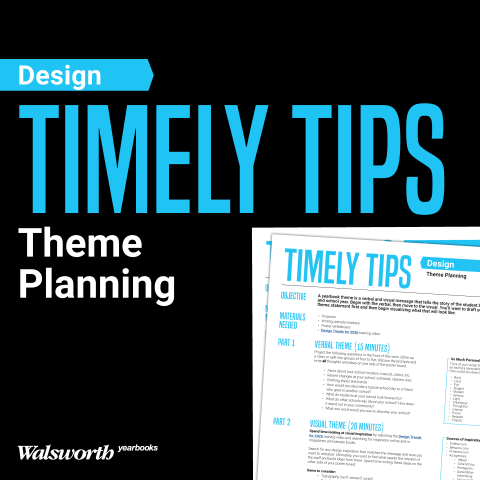Your yearbook theme serves as the soul of your publication – a unifying thread that weaves the stories, memories and faces of the school year together. Yearbook advisers guiding students through this crucial process need a blend of creativity, collaboration and strategic thinking. The latest Walsworth Yearbooks Timely Tips lesson plan helps you and your staff develop a theme that truly resonates with a step-by-step guide.
VERBAL EXPLORATION
Before diving into visual concepts, shape your verbal theme through collective brainstorming. This allows you to explore the identity and reputation of your school as well as define the unique character of the year.
- Project thought-provoking questions as a starting point. Depending on your class size, you may tackle this as a class or split students into smaller groups of four or five, but the goal is to generate a wide range of ideas. Discuss the following, but feel free to add to this list:
- What are the most-identifying facts about your school (location, mascot, colors, etc.)?
- What recent changes at your school, such as schedule, classes and size, have impacted student life?
- What are the most popular clothing styles and trends?
- How would you describe a typical school day to a friend who goes to another school?
- What do students at your school look forward to?
- What do other schools say about your school? How does it stand out in your community?
- What one word would you use to describe your school or reputation?
- Consider both tangible, surface-level aspects of their school and intangible concepts. The surface-level aspects include things like your location, mascot and colors. But don’t just rely on the surface-level things – dive deeper by considering recent changes that have impacted the school community. Perhaps a new schedule, a popular new class or a significant shift in the student population. These changes offer a unique lens through which to view the year. When you bring these ideas together, these elements often provide a solid foundation for a theme.
Style trends also offer surprising thematic inspiration reflecting the current culture of your school. Asking students to describe a typical school day to an outsider encourages them to identify the defining characteristics and routines of their high school experience. What are the moments they anticipate most? Homecoming, pep rallies, sporting events, academic achievements – these shared experiences can form the core of a theme.
- Define your brand. It’s also worth reflecting upon the school’s external perception and reputation. What do other schools or community members say about your school? What makes it stand out? Honing in on your school’s unique identity can build powerful thematic concepts. The seemingly simple task of choosing one word to describe the school can unlock a central idea that encapsulates the year.
Record all these diverse thoughts and ideas on one side of a poster board to create a visual representation of the brainstorming session.
DESIGN INSPIRATION
Once you generate a robust collection of verbal ideas, shift your focus to the visual theme.
- Identify trends. The Design Trends for 2026 training video can provide fresh design inspiration during this phase. This video provides a contemporary overview of current design aesthetics, helping students understand the latest trends in typography, color, graphic elements, photo treatments and composition.
Encourage students to actively engage with the video, taking notes and identifying elements that resonate with the verbal ideas they’ve already explored. Completing the Google Forms for each video will help. Like the videos suggest, students should keep a filing system of some sort to store ideas, be that in their phone, on your server or a Pinterest board.
- Seek inspiration. Beyond the training video, guide them to search for visual inspiration from various sources including online platforms, design websites, magazines and sample yearbooks. The Walsworth Showcase Galleries, particularly our Theme Gallery, President’s Collection Gallery and Caught Our Eye Gallery, offer a wealth of examples and design tips. Explore our galleries, training videos and blog posts for further inspiration and guidance on visual storytelling in yearbooks.
- Align with your message. As students discover compelling visuals, prompt them to consider how these elements align with the message and tone they want to convey through their verbal theme. The goal is to find visual concepts that spark the staff’s interest and provide a springboard for further creative development. On the other side of the poster board have students document these visual ideas considering specific elements:
- Typography: Explore the impact of different font styles, such as serif, sans serif, handwritten and script, and how they contribute to the overall mood.
- Color: Discuss the use of bright vibrant palettes, muted sophisticated tones or natural earthy hues and their emotional connotations. How does each play into the message of your theme?
- Graphic Elements: Analyze the potential of color blocks typography used as design elements shapes and line art to create visual interest and reinforce the theme.
- Photo Treatments: Consider the artistic possibilities of black and white photography, duotone effects and creative cut-outs to enhance the visual narrative.
- Composition: Emphasize the importance of white space, strategic alignment and the effective use of multiple modular elements on a page.
FINDING THE OVERLAP
After this initial theme development session, display all the generated boards at the front of the room. This allows the entire staff to observe the full scope of ideas, both verbal and visual. Students should not eliminate anything yet – you never know what will springboard an even better idea.
- Note emerging patterns. Next, identify overlapping themes, connections and recurring patterns that emerge from both sides of the brainstorming process. Where do the verbal descriptions find visual echoes? Do certain colors or graphic styles seem to align with specific feelings or events discussed?
Documenting these overlaps is essential as it lays the foundation for a cohesive and impactful yearbook theme. These points of convergence represent the strongest and most promising thematic directions.
- Live in the what-if. This is the time to dream big. Imagine if you married different verbal and visual elements – what would that marriage look like? Would they live in harmony? Would they clash? Would your verbal and visual fight for dominance or complement each other? Find the pairing that works for your vision.
- Sleep on it. Take some time to think about the ideas that have emerged, and next time you meet, the staff can narrow down the top theme contenders through a vote. These selected themes will then be further developed with concrete concepts for the yearbook cover, divider pages and overall layout design, ensuring a unified and compelling narrative throughout the publication.
The journey of crafting a yearbook theme is a collaborative and creative one, and by following these steps and leveraging resources Walsworth provides, your staff can create a yearbook that truly captures the essence of the school year.




